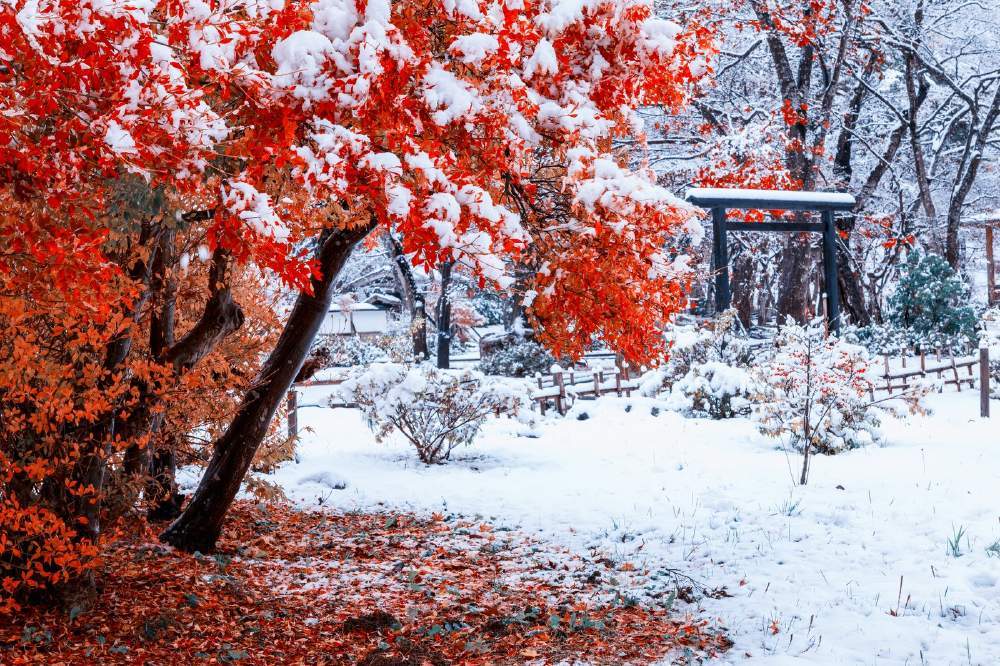A Collection of 32 Weather Kanji and Natural Phenomena
Japanese kanji beautifully capture the essence of nature, reflecting not only meteorological conditions but also the emotions and cultural significance associated with them. From the tranquility of “Hare” (晴, sunny) to the intensity of “Arashi” (嵐, storm), each character conveys a deeper meaning beyond its literal translation. The Japanese language embraces subtle changes in weather and natural phenomena, expressing the fleeting beauty of the seasons, much like in traditional poetry and art.
Below is a list of 32 weather-related kanji, each representing a unique aspect of Japan’s deep connection with nature.
Weather and other natural phenomena list
Please Note:
The provided readings and pronunciations are approximations based on Japanese phonetics and may vary from actual pronunciation. These should be used as a reference only. For precise pronunciation and meanings, please refer to a reliable dictionary or an authoritative resource.
- 雲 【kumo】
Cloud – Symbolizing transience, clouds appear in Japanese poetry as metaphors for passing emotions and impermanence. - 曇 【kumori】
Cloudy – A day with overcast skies, often associated with a calm and introspective mood. - 雨 【ame】
Rain – Rain is deeply ingrained in Japanese aesthetics, bringing both nostalgia and renewal, often celebrated in haiku and traditional music. - 虹 【niji】
Rainbow – A rare and beautiful natural wonder, representing hope and fleeting beauty in Japanese culture. - 風 【kaze】
Wind – The wind is a powerful symbol in Japanese literature, evoking movement, change, and impermanence. - 雪 【yuki】
Snow – A symbol of purity and stillness, snow has long been admired in Japanese poetry and seasonal traditions. - 嵐 【arashi】
Storm – A force of nature that represents both destruction and cleansing, storms hold deep symbolic meaning in Japanese folklore. - 天候 【tenkou】
Weather – The overall conditions of the sky, crucial in daily life and seasonal celebrations. - 晴 【hare】
Clear (Sunny) – The concept of “Hare” extends beyond weather, symbolizing joyful occasions and spiritual clarity in Japanese tradition. - 霞 【kasumi】
Haze – Often appearing in spring, haze is poetically linked to gentle transitions in nature. - 雷 【kaminari】
Thunder – Revered in mythology, thunder represents the gods’ power and the dramatic force of nature. - 霧 【kiri】
Fog – Mystical and serene, fog adds an air of mystery to landscapes and storytelling in Japan. - 霜 【shimo】
Frost – A delicate yet powerful sign of winter’s arrival, often associated with quiet resilience. - 露 【tsuyu】
Dew – A fleeting natural phenomenon, symbolizing the transient nature of life in Japanese philosophy. - 波 【nami】
Wave – Representing movement and fluidity, waves are iconic in Japanese art, notably in ukiyo-e prints like *The Great Wave off Kanagawa*. - 潮 【shio】
Tide – The ocean’s rhythm, symbolizing time, fate, and the interconnectedness of nature. - 渦 【uzu】
Whirlpool – A dramatic natural force, often associated with chaos and transformation. - 洪水 【kousui】
Flood – While floods bring destruction, they also represent renewal and change. - 地震 【jishin】
Earthquake – A reminder of nature’s unpredictable power, deeply ingrained in Japanese history and resilience. - 災 【sai】
Disaster – A general term for calamities, reflecting the country’s experience with natural challenges. - 暗闇 【kurayami】
Darkness – Often used symbolically to represent the unknown or introspection. - 光明 【koumyou】
Brightness – A hopeful contrast to darkness, signifying clarity and enlightenment. - 影 【kage】
Shadow – Shadows in Japanese culture hold both mystery and beauty, often used metaphorically. - 煙 【kemuri】
Smoke – Associated with fire and transformation, smoke appears in many cultural rituals. - 電気 【denki】
Electricity – A modern addition to the natural forces shaping daily life. - 火炎 【kaen】
Flame – Fire represents both destruction and warmth, essential in traditional festivals. - 台風 【taifuu】
Typhoon – A powerful storm that has shaped Japan’s geography and history. - 竜巻 【tatsumaki】
Tornado – A rare but intense force of nature. - 雹 【hyō】
Hail – Ice pellets that accompany powerful storms, often leaving striking natural patterns. - 霰 【arare】
Sleet – Light ice particles that create a wintery atmosphere. - 霧雨 【kirisame】
Drizzle – A gentle and melancholic form of rain, commonly found in Japanese seasonal expressions. - 氷【kōri】
Ice – A symbol of both beauty and fragility, ice plays a key role in Japanese seasonal imagery.
You can check the correct pronunciation using this link: Forvo – Native Pronunciation Guide (Click to listen to native speaker recordings).
Discover the Beauty of Japanese Weather Kanji
These 32 kanji are more than just weather-related words—they are a reflection of Japan’s deep appreciation for nature. Whether capturing the soft mist of early morning or the fury of a storm, each kanji tells a story that has been woven into the country’s poetry, art, and daily life.
Let these kanji inspire you to see the world through a new lens, one where the shifting seasons and elements become part of a greater cultural and emotional landscape. 🌿🌧️☀️


Comments